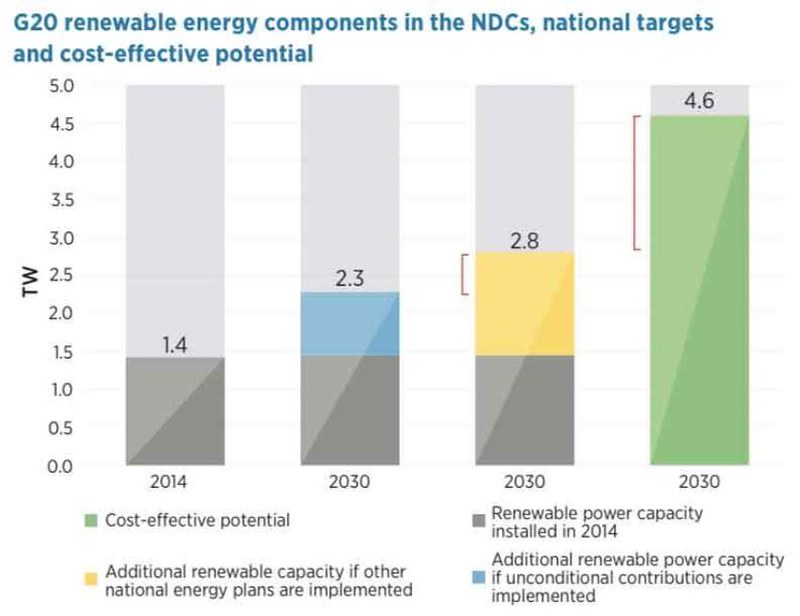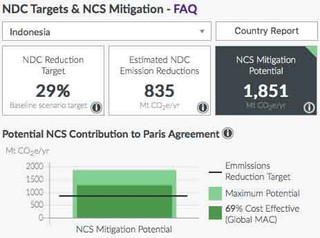兩年前在巴黎的氣候大會上,各國政府為了抑制氣候變遷許下兩個承諾。其中之一是讓工業化前就開始的全球暖化升溫控制在「遠低於」2ºC,並且以1.5ºC為目標。另一個承諾則帶我們走入一個全然不同的世界,各國自訂的減碳計畫在這個世紀末前,會把全球暖化升溫控制在3ºC左右。
這就是為什麼在波昂聯合國氣候大會現場的走廊跟咖啡吧,動不動就聽到有人在講「壓低(碳排)曲線」跟「雄心再加碼」。
態勢很明顯,現在盛行的說法是,許多政府還是不信可以既不傷害國內經濟,又達到升溫遠低於攝氏2度的減碳成效。這些政府對願景喜歡歸喜歡,但是對達成願景需採取的路徑還生不出好感。
但是據最近的兩篇研究顯示,還有另一個可能同等重要的答案:這些國家根本就還未詳細檢視自己國內現況,還沒看過他們在其他場域許下的承諾,或是還沒發現其他減碳的可能性。
IRENA:各國大幅低估2030年前的再生能源裝置容量
其中一份研究來自國際再生能源總署(International Renewable Energy Agency, IRENA)。
不意外地,許多國家對《巴黎協定》主要的承諾內容,也就是國家自訂貢獻(Nationally Determined Contributions, NDC),都跟大幅推動再生能源的計畫相關。
為了看看各國提議了什麼再生能源推動的計畫。IRENA的研究人員把各國的國家自訂貢獻(NDC)檢視了一輪。IRENA發現,各國NDC裡面包含的再生能源計畫加總起來,在2015到2030年之間,預計平均再生能源裝置容量年成長率為3.6%。
聽起來好像蠻有志氣的是嗎?但是,若跟2010到2015間8.1%的年成長率比起來,發展再生能源的志氣就顯得沒那麼長進了。
再生能源裝設率發展到這樣的停滯不前,就算發電成本持平不降,都是非比尋常的情形。況且成本當然會變動,尤其是風能與太陽能。太陽能發電成本已在過去五年下跌約七成。風能設施原本就比太陽能便宜,所以數字沒那麼驚人,但根據國際能源總署(International Energy Agency, IEA)的報告,光去年一年內風能成本就降低了一成。
還有,如你所預期的,同一份IEA報告顯示,再生能源的裝設率不但沒有下降,還在一年內就上升了8%。也就是說,整體而言,各國的國家自訂貢獻大幅低估了2030年前將裝設的再生能源裝置容量。

IRENA也發現,一些國家在NDC裡預估的目標,比他們在自己的國家發展計畫裡所提的還保守客氣。從非洲各國的NDC加總看來,在2030年前預計將會擴增40GW的再生能源裝置容量。但在非洲各國的國家發展計畫裡,至少預計將有110GW。
所以,光是在NDC中更正確地反映各國的國家發展計畫內容,許多國家預測的減碳目標就會比現行版本更上一層樓,而且如果各國反映經濟面可能達成的目標,發展再生能源的雄心還會再進一步成長。
自然就是美:自然氣候解決方案
第二份研究來自「自然氣候解決方案」(Natural Climate Solution)的領域。基礎概念是將土地保持或回歸到吸收與儲存碳的狀態,包括盡可能讓土地達到自然的狀態,或是用可以留住碳的方式使用土地,例如不用深耕法,改採「最低耕作法」(minimum-till)務農。
地球越來越擁擠,很明顯地,這個解決方案跟其他土地需求間將需要做出取捨。但如果這些解決方案施行得當,野生動物跟人類也會跟著受益,因此也有明顯的吸引力。
一、兩個月前,一篇關鍵的科學研究加總了自然氣候解決方案中,對達成巴黎協定裡氣候目標的潛在貢獻,結論是,在合理的成本範圍內可以達成1/3的目標。

主筆該研究的美國自然保育協會(The Nature Conservancy)推出了一套線上工具,可以看到全球各國若採行這些「自然方案」可達到的減碳潛力。
某些國家的潛力特別高,像印尼光是透過符合成本效益的自然解決方案,可以達到的減碳承諾就超過該國NDC。像這樣的工具是否有用,將取決在輸入的資料品質,所以有人會說,輸入的數據跟達成的結論也會跟著時間改變。
無論如何,這個例子告訴我們,有些國家也許可在不添太多麻煩的情況下,加碼他們的NDC承諾。雖說某些國家(像印尼)可能還是會需要拿到自2009年來的財務支持承諾,來實現完整的減碳潛力。
那英國呢?
即便英國的氣候變遷因應計畫比多數國家細緻,但也可能低估了自然氣候解決方案跟再生能源的減排潛力。
根據美國自然保育協會的工具估算,透過造林與其他土地利用改變,就可能達成六分之一的NDC承諾減碳目標(因當初提出共同承諾,現行英國的NDC包含在歐盟NDC中)。但在現行公布的歐盟NDC中,還看不出政府提出目標時是否已納入造林跟土地利用改變的減碳潛力。
同時,據彭博新能源財經(Bloomberg New Energy Finance)最新的分析估計,英國在2026年前,超過一半以上的發電量可由再生能源供應。但是英國政府卻認為,2026年的十年後,再生能源發展還會在龜速爬行,僅能供應英國不到五成的電力。
以上種種,並不代表如果所有的國家重新徹底計算他們的NDC,我們就會神奇地達成巴黎協定中「遠低於2ºC」的抑制暖化目標。完全不是這個意思。
但這些研究的確指出了,除了許多政府已提出的減碳目標外,不管是讓各國NDC跟國家發展計畫的減碳目標一致,或採自然氣候解決方案,還是採行其他的減碳方式, 有更多減碳的潛力尚未開發。若能更大膽地開發減碳方案,才能讓我們離當初在巴黎許下的共同期望越來越近。
At the Paris summit two years ago, governments made two separate promises on curbing the extent of climate change.
In one, they pledged to keep global warming since pre-industrial times ‘well below' 2 degrees Celsius, and to aim for 1.5ºC.

In the other, they put forward national plans on curbing carbon emissions that take us to a very different world – with global warming of around 3ºC by the end of the century.
That's why phrases such as ‘bend the curve' and ‘ramp up the ambition' are heard so often in the corridors and coffee bars of the UN convention centre here in Bonn.
The prevailing theory is – and it's a pretty obvious one – that many governments aren't yet convinced that they can cut emissions on the scale needed to usher in that ‘well below 2ºC' world without inflicting substantial pain on their economies. They like the vision, but not yet the pathway needed to get there.
But two recent pieces of research suggests there's another answer that may be just as important: they haven't looked hard enough at what's happening in their own countries, at what they've promised in other fora, or at what's possible.
Good knight IRENA
One comes from IRENA, the International Renewable Energy Agency.
Unsurprisingly, plans for a big rollout of renewable energy form a centrepiece of many countries' pledges into the Paris Agreement, which are known as Nationally Determined Contributions (NDCs).
IRENA boffins simply went through countries' NDCs to see what they're proposing for renewables.
Here's the headline figure. Totting up the renewable energy rollout plans contained in the NDCs adds up to a projected increase in renewable energy capacity of 3.6% per year between 2015 and 2030.
Sounds ambitious? Well – not when the annual growth rate seen 2010-2015 was 8.1%.
Even if prices were constant it would be extraordinary to see the deployment rate grinding to a halt like this – and of course, prices aren't constant, certainly not for wind and solar. Solar prices have fallen by about 70% in the last five years. The figure for wind is less spectacular as it was already cheaper than solar – but the International Energy Agency reports a price drop of 10% over the last year.
And, as you'd expect, that same IEA report showed that the installation rate of renewables is increased, by 8% in a year, rather than decreasing.
That suggests that overall, the NDCs vastly underestimate the amount of renewable energy capacity that will be installed over the years to 2030.

IRENA also found that some countries are forecasting less ambition in their NDCs than they are in their national development plans.
Across Africa, NDCs project an expansion of 40 gigawatts (GW) in renewable capacity by 2030. But national development plans show Africa can expect 110 GW at least.
So, simply by reflecting their national plans more accurately in their NDCs, many countries would be able to forecast more ambitious emission curbs than they have yet put forward. And the ambition would grow still further if countries reflected what's economically likely.
Eau naturale
The second bit of research comes in the field that's becoming known as ‘natural climate solutions'. Here, the basic idea is to keep land in, or return it to, a condition in which it absorbs and stores carbon. Which in some cases means attaining as natural a state as possible, and in others means using land in ways that retain carbon, for example doing ‘minimum till' farming rather than deep ploughing.

There are obvious trade-offs here with other demands for land on an increasingly crowded planet, but seeing as many of these approaches bring benefits for wildlife or people if they're done well, there are obvious attractions too.
A couple of months back we saw a major scientific paper totting up the potential contribution of natural climate solutions to achieving the Paris climate target. The conclusion: they can get us about one-third of the way there at reasonable cost.
Now, The Nature Conservancy, the US-based conservation charity which led that scientific paper, has released a cool online tool that allows you to see, for every country in the world, what potential exists for meeting NDC targets through these ‘natural solutions'.
For some, it's pretty big: Indonesia can achieve more than its entire NDC pledge through cost-effective natural solutions alone.
Now, such a tool can only be as good as the data going into it. And one suspects that the numbers in and therefore the conclusions out are going to change over time.
Nevertheless, it illustrates that some countries may be able to increase their NDC pledges without too much bother – although in some cases (Indonesia still being a good example) they're likely to need the financial support they've been promised since 2009 in order to realise the full potential.
And at home?
Even countries such as the UK, which are more sophisticated than most in their climate change plans, may be under-estimating the potential of both natural climate solutions and renewables to cut emissions.
The Nature Conservancy's tool estimates that afforestation and other land-use changes could bring about one-sixth of the emission cut pledged in our NDC (which, just to be clear, is currently the EU's NDC as the bloc made a joint pledge). It's not clear – genuinely not clear from published plans, I'm not having a dig – whether the government has factored this in or not.
Meanwhile the latest analysis from Bloomberg New Energy Finance reckons that renewables could provide more than half our electricity by 2026. By contrast, the government thinks [pdf link] that a decade after that, renewables will still be chugging along at under half.
Now, all of this doesn't mean that if countries re-calculate their NDCs thoroughly, we'll magically be on target for the 'well below 2ºC' world of the Paris Agreement. Almost certainly that's not the case.
But it does suggest there's more potential there than many governments realise, in these two areas and maybe in others, to become bolder – and so take us closer to the world they said in Paris that they want.
※ 本文原刊於經濟學人智庫部門 Energy and Climate Intelligence Unit(ECIU)部落格。依共創授權 CC BY-ND 4.0轉載與翻譯。
※ 中文譯文與台達電子文教基金會低碳生活部落格合作刊登




